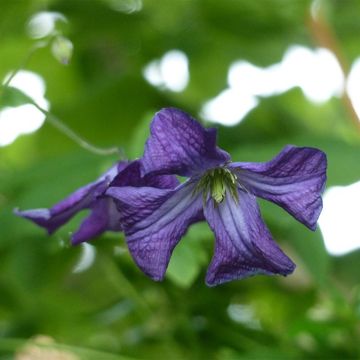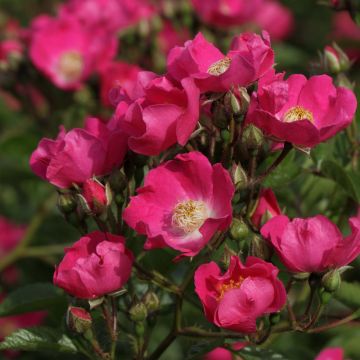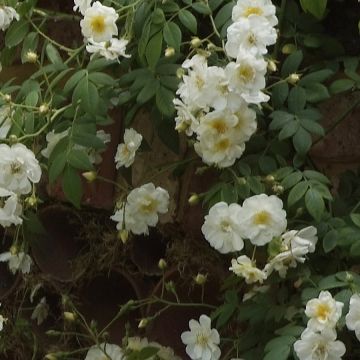Shipping country and language
Your country of residence may be:
Your country of residence is:
For a better user experience on our website, you can select:
Your shipping country:
Andorra
Austria
Belgium
Bulgaria
Canada
Chile
Croatia
Cyprus
Czechia
Denmark
Estonia
Finland
France
Germany
Greece
Hungary
Iceland
Ireland
Italy
Latvia
Lithuania
Luxembourg
Malta
Monaco
Netherlands
Poland
Portugal
Romania
Slovakia
Slovenia
Spain
Sweden
Switzerland
United Kingdom
We only deliver seed and bulb products to your country. If you add other products to your basket, they cannot be shipped.
Language:
French
German
Spanish
English
My Account
Hello
My wish lists
Plantfit
Log in / Register
Existing customer?
New customer?
Create an account to track your orders, access our customer service and, if you wish, make the most of our upcoming offers.


Clématite - Clematis viticella Bonanza
Clematis Bonanza
Clematis x viticella Bonanza™ 'evipo031'
Italian Leather Flower, Purple Clematis, Virgin's Bower
Order in the next for dispatch today!
Dispatch by letter from €3.90.
Delivery charge from €5.90 Oversize package delivery charge from €6.90.
More information
This item is not available in your country.
Schedule delivery date,
and select date in basket
This plant carries a 6 months recovery warranty
More information
We guarantee the quality of our plants for a full growing cycle, and will replace at our expense any plant that fails to recover under normal climatic and planting conditions.
From €5.90 for pickup delivery and €6.90 for home delivery
Express home delivery from €8.90.
Does this plant fit my garden?
Set up your Plantfit profile →
Description
Clemtis 'Bonanza is a hybrid of the Italian Clematis or Clematis viticella, from which it inherited its robustness and long summer flowering. Its single flowers are shaped like small bluish-purple stars with delicately wavy petals, topped with bright white stamens. Over time, the centre becomes spotted with purple-red before fading to white, leaving a veined pink-purple border. Despite its small size, this deciduous climber is floriferous and transforms into a colourful cloak from June to September! It is an ideal climber for covering a boring hedge or an unattractive fence. Its small size makes it suitable for smaller gardens and pot cultivation. It is vigorous and hardy, it requires a bright exposure and its base needs a shaded location in permeable, light, deep, and moist soil.
Clematis belong to the Ranunculaceae family. They are found in Europe, the Himalayas, China, Australia and North and Central America. The 'Bonanza' variety was selected in the United Kingdom by Raymond Evison in 1996. It descends from the Clematis viticella, native to southern Europe, renowned for its natural resistance to clematis wilt. It is a perennial, semi-woody, climbing herbaceous plant that will reach an average height of 3m (10ft), with a spread of 1.5m (5ft). This clematis bears well-opened flowers, 5 to 8cm (2 to 3in) in diameter, which appear on the current year's shoots, from June until the end of summer, in successive waves. The flowers are solitary or grouped in small clusters. When they appear, they open into stars, revealing 4 to 6 delicately wavy, bluish-purple petals initially with purple-red infused central lines that fade to white, with veined margins. It is the clear heart of the flower that is most charming, the light yellow tips of the stamens beautifully enhance the purple and blue hues of the petals. The smooth leaves are divided into 3 elliptical to lanceolate, olive-green leaflets. The foliage dries up and dies in winter. This clematis clings to its support or host plant through petioles transformed into tendrils.
Plant clematis with your climbing roses ('New Dawn', 'Pomponella', 'Bouquet Parfait'), to extend the flowering of your walls and pergolas until the end of summer. It is a diverse genus with colours, shapes, and sizes for every taste. Take advantage of their ease of cultivation to give your garden a romantic and bohemian touch. 'Bonanza' pairs well with the blue-tinged white flowers of similar small climbers like 'Ice Blue' clematis, or the white flowers with purple-red stamens of 'Miss Bateman' to climb a fence or cover a wall exposed to the morning sun.
Tips: Avoid excessive fertiliser applications that stimulate foliage growth at the expense of flowers. Do not mulch to avoid excessive moisture.
Clematis Bonanza in pictures


Plant habit
Flowering
Foliage
Botanical data
Clematis
x viticella
Bonanza™ 'evipo031'
Ranunculaceae
Italian Leather Flower, Purple Clematis, Virgin's Bower
Cultivar or hybrid
Other Clematis Viticella
Planting and care
The 'Bonanza' Clematis prefers non-scorching but sunny and bright situations. It will even flower in bright shade, especially in very sunny regions. Plant it in fertile, well-draining soil, enriched with compost, shading the roots and the base of the stem (with a flat tile for example). Clematis can succumb to wilt in too wet soil, but varieties with the genes of C.viticella seem more resistant to this disease. They also tolerate heat and relatively dry soils in summer. Plant it with the root ball at an angle, covering it with 3 cm (1in) of soil, in well-worked soil, lightened with good compost and coarse sand. After planting, cut back the stems to about 30 cm (12in) from the base above a healthy pair of buds. Water regularly in the first few weeks, but be careful not to let the water stagnate as this can cause fungus to develop at the neck. Mulch all clematis in February with garden compost or well-rotted manure, avoiding direct contact with the stems. Train the stems, without crushing them, until the plant clings for itself. Clematis also like to grow freely on neighbouring plants. After a few years, cover the base of your climbing clematis with a small mound of soil, this will reduce the risk of wilt while promoting the growth of vigorous new shoots from the crown. Voles and caterpillars can attack clematis and devour the stems. Aphids and greenhouse whiteflies are also potential pests.
Planting period
Intended location
Care
This item has not been reviewed yet - be the first to leave a review about it.
Foolproof climbers
Haven't found what you were looking for?
Hardiness is the lowest winter temperature a plant can endure without suffering serious damage or even dying. However, hardiness is affected by location (a sheltered area, such as a patio), protection (winter cover) and soil type (hardiness is improved by well-drained soil).

Photo Sharing Terms & Conditions
In order to encourage gardeners to interact and share their experiences, Promesse de fleurs offers various media enabling content to be uploaded onto its Site - in particular via the ‘Photo sharing’ module.
The User agrees to refrain from:
- Posting any content that is illegal, prejudicial, insulting, racist, inciteful to hatred, revisionist, contrary to public decency, that infringes on privacy or on the privacy rights of third parties, in particular the publicity rights of persons and goods, intellectual property rights, or the right to privacy.
- Submitting content on behalf of a third party;
- Impersonate the identity of a third party and/or publish any personal information about a third party;
In general, the User undertakes to refrain from any unethical behaviour.
All Content (in particular text, comments, files, images, photos, videos, creative works, etc.), which may be subject to property or intellectual property rights, image or other private rights, shall remain the property of the User, subject to the limited rights granted by the terms of the licence granted by Promesse de fleurs as stated below. Users are at liberty to publish or not to publish such Content on the Site, notably via the ‘Photo Sharing’ facility, and accept that this Content shall be made public and freely accessible, notably on the Internet.
Users further acknowledge, undertake to have ,and guarantee that they hold all necessary rights and permissions to publish such material on the Site, in particular with regard to the legislation in force pertaining to any privacy, property, intellectual property, image, or contractual rights, or rights of any other nature. By publishing such Content on the Site, Users acknowledge accepting full liability as publishers of the Content within the meaning of the law, and grant Promesse de fleurs, free of charge, an inclusive, worldwide licence for the said Content for the entire duration of its publication, including all reproduction, representation, up/downloading, displaying, performing, transmission, and storage rights.
Users also grant permission for their name to be linked to the Content and accept that this link may not always be made available.
By engaging in posting material, Users consent to their Content becoming automatically accessible on the Internet, in particular on other sites and/or blogs and/or web pages of the Promesse de fleurs site, including in particular social pages and the Promesse de fleurs catalogue.
Users may secure the removal of entrusted content free of charge by issuing a simple request via our contact form.
The flowering period indicated on our website applies to countries and regions located in USDA zone 8 (France, the United Kingdom, Ireland, the Netherlands, etc.)
It will vary according to where you live:
- In zones 9 to 10 (Italy, Spain, Greece, etc.), flowering will occur about 2 to 4 weeks earlier.
- In zones 6 to 7 (Germany, Poland, Slovenia, and lower mountainous regions), flowering will be delayed by 2 to 3 weeks.
- In zone 5 (Central Europe, Scandinavia), blooming will be delayed by 3 to 5 weeks.
In temperate climates, pruning of spring-flowering shrubs (forsythia, spireas, etc.) should be done just after flowering.
Pruning of summer-flowering shrubs (Indian Lilac, Perovskia, etc.) can be done in winter or spring.
In cold regions as well as with frost-sensitive plants, avoid pruning too early when severe frosts may still occur.
The planting period indicated on our website applies to countries and regions located in USDA zone 8 (France, United Kingdom, Ireland, Netherlands).
It will vary according to where you live:
- In Mediterranean zones (Marseille, Madrid, Milan, etc.), autumn and winter are the best planting periods.
- In continental zones (Strasbourg, Munich, Vienna, etc.), delay planting by 2 to 3 weeks in spring and bring it forward by 2 to 4 weeks in autumn.
- In mountainous regions (the Alps, Pyrenees, Carpathians, etc.), it is best to plant in late spring (May-June) or late summer (August-September).
The harvesting period indicated on our website applies to countries and regions in USDA zone 8 (France, England, Ireland, the Netherlands).
In colder areas (Scandinavia, Poland, Austria...) fruit and vegetable harvests are likely to be delayed by 3-4 weeks.
In warmer areas (Italy, Spain, Greece, etc.), harvesting will probably take place earlier, depending on weather conditions.
The sowing periods indicated on our website apply to countries and regions within USDA Zone 8 (France, UK, Ireland, Netherlands).
In colder areas (Scandinavia, Poland, Austria...), delay any outdoor sowing by 3-4 weeks, or sow under glass.
In warmer climes (Italy, Spain, Greece, etc.), bring outdoor sowing forward by a few weeks.



















